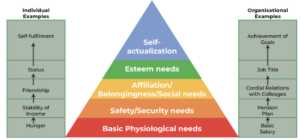

During Covid, we were all summoned to stay at home, which most of the UK did. I was fortunate to be in an industry that allowed people to continue working from the comfort of their homes. At first, this was so easy and enjoyable, but after time, something was missing for me: it was a big motivational factor – People Interaction – social needs.
This social motivational factor has continued for quite a few people, and it got me thinking about motivation and what motivates me to get up in the morning and continue to work from home. I used to **** being with people, helping people develop, and challenging people to think.
So how many business managers, team leaders, and heads of department have considered what motivational factors their people value, and how do you use that information to encourage, persuade etc? How do you, as a leader, motivate your team members? Do you know, apart from money (which, by the way, isn’t a motivator, it’s a need/desire), what motivates your individual team members?
Below are some motivational theories that, as leaders in business, you should be aware of, then learn and practice how to motivate your team members individually and as a team to do more, go the extra mile, drive change and challenge them to progress.
The most commonly known motivation factor is Herzberg’s two-factor theory which looks at Job Dissatisfaction (hygiene factor) and Job Satisfaction (motivational factor). Overcoming the Hygiene Theories can turn into Motivational Theories and help retain good employees. Another motivational theory is Adams Equity Theory which looks at Inputs v outputs
This looks at equality in the workplace, when an employee has the same (similar) role as another employee and puts in effort, they expect to receive equal output buy the organisation. Employers need to be wise because it is not ******* for staff to share their pay details, and most do. But if one staff member feels they put in more effort or work longer than the other staff member but don’t receive a the same reward they can feel demotivated and undervalued. This creates resentment amongst the team. In this instance, the aggrieved employee will almost certainly look for alternative employment.

Maslow’s Hierarchy of Needs is a motivational factor that covers the basic items that most people go to work for, such as physiological, safety, social, esteem and self-actualisation. Taken from “geeksforgeeks” this image demonstrates the individuals and company’s understanding.
This is probably one of the best diagrams I have come across that depicts the needs of the individual and the company showing how they overcome the motivational factor at each stage of the pyramid. These basic items, such as a job description, become important for an individual to understand what is expected; this is one way he exceeds expectations.
If any manager out there is struggling to retain staff and is not able to demonstrate a motivational department then please start to collaborate with them to find out how to motivate your team, once you achieve this they will be engaged in the business and support new initiatives quicker.
Keeping people and teams motivated helps with the bottom line figures for any business, the affect of client retention is impacted by high staff turnover, especially with account management. People buy from people and if there’s a good relationship made and that staff member leaves, the business normally follows, especially if your business relies on renewals of contracts.
For anymore information on motivational theories feel free to get in touch, [email protected]



